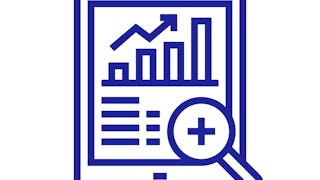Ready to start a career in Data Analysis but don’t know where to begin? This course presents you with a gentle introduction to Data Analysis, the role of a Data Analyst, and the tools used in this job. You will learn about the skills and responsibilities of a data analyst and hear from several data experts sharing their tips & advice to start a career. This course will help you to differentiate between the roles of Data Analysts, Data Scientists, and Data Engineers.


Introduction to Data Analytics
This course is part of multiple programs.

Instructor: Rav Ahuja
870,737 already enrolled
Included with
(20,025 reviews)
Recommended experience
What you'll learn
Explain what Data Analytics is and the key steps in the Data Analytics process
Differentiate between different data roles such as Data Engineer, Data Analyst, Data Scientist, Business Analyst, and Business Intelligence Analyst
Describe the different types of data structures, file formats, and sources of data
Describe the data analysis process involving collecting, wrangling, mining, and visualizing data
Skills you'll gain
Details to know

Add to your LinkedIn profile
See how employees at top companies are mastering in-demand skills

Build your subject-matter expertise
- Learn new concepts from industry experts
- Gain a foundational understanding of a subject or tool
- Develop job-relevant skills with hands-on projects
- Earn a shareable career certificate

There are 5 modules in this course
In this module, you will learn about the different types of data analysis and the key steps in a data analysis process. You will gain an understanding of the different components of a modern data ecosystem, and the role Data Engineers, Data Analysts, Data Scientists, Business Analysts, and Business Intelligence Analysts play in this ecosystem. You will also learn about the role, responsibilities, and skillsets required to be a Data Analyst, and what a typical day in the life of a Data Analyst looks like.
What's included
9 videos5 readings4 assignments1 discussion prompt
In this module, you will learn about the different types of data structures, file formats, sources of data, and the languages data professionals use in their day-to-day tasks. You will gain an understanding of various types of data repositories such as Databases, Data Warehouses, Data Marts, Data Lakes, and Data Pipelines. In addition, you will learn about the Extract, Transform, and Load (ETL) Process, which is used to extract, transform, and load data into data repositories. You will gain a basic understanding of Big Data and Big Data processing tools such as Hadoop, Hadoop Distributed File System (HDFS), Hive, and Spark.
What's included
11 videos2 readings4 quizzes
In this module, you will learn about the process and steps involved in identifying, gathering, and importing data from disparate sources. You will learn about the tasks involved in wrangling and cleaning data in order to make it ready for analysis. In addition, you will gain an understanding of the different tools that can be used for gathering, importing, wrangling, and cleaning data, along with some of their characteristics, strengths, limitations, and applications.
What's included
7 videos2 readings4 quizzes
In this module, you will learn about the role of Statistical Analysis in mining and visualizing data. You will learn about the various statistical and analytical tools and techniques you can use in order to gain a deeper understanding of your data. These tools help you to understand the patterns, trends, and correlations that exist in data. In addition, you will learn about the various types of data visualizations that can help you communicate and tell a compelling story with your data. You will also gain an understanding of the different tools that can be used for mining and visualizing data, along with some of their characteristics, strengths, limitations, and applications.
What's included
8 videos2 readings4 quizzes
In this module, you will learn about the different career opportunities in the field of Data Analysis and the different paths that you can take for getting skilled as a Data Analyst. At the end of the module, you will demonstrate your understanding of some of the basic tasks involved in gathering, wrangling, mining, analyzing, and visualizing data.
What's included
8 videos4 readings2 assignments1 peer review
Earn a career certificate
Add this credential to your LinkedIn profile, resume, or CV. Share it on social media and in your performance review.
Explore more from Data Analysis
 Status: Free Trial
Status: Free TrialLearnQuest
 Status: Free Trial
Status: Free Trial Status: Preview
Status: PreviewBall State University
 Status: Free Trial
Status: Free TrialUniversity of Pennsylvania
Why people choose Coursera for their career




Learner reviews
20,025 reviews
- 5 stars
80.40%
- 4 stars
16.38%
- 3 stars
2.04%
- 2 stars
0.46%
- 1 star
0.69%
Showing 3 of 20025
Reviewed on Jul 20, 2023
All content was related and helpful, the only issue I see is the final assessment, peer graded. It looks like some students who want to get feedback on others', do not read the answers at all !
Reviewed on Sep 17, 2024
Thank you for creating this course. As a beginner trying to become mor analytically sound using data analytics, it was a great start to see the extent of tools that we can in subsequent courses.
Reviewed on Oct 16, 2021
Pretty good course. In my opinion the reading material was a bit brief and did not really cover the quiz questions. Other than that though it was pretty clear and relatively easy to understand.

Open new doors with Coursera Plus
Unlimited access to 10,000+ world-class courses, hands-on projects, and job-ready certificate programs - all included in your subscription
Advance your career with an online degree
Earn a degree from world-class universities - 100% online
Join over 3,400 global companies that choose Coursera for Business
Upskill your employees to excel in the digital economy
Frequently asked questions
To access the course materials, assignments and to earn a Certificate, you will need to purchase the Certificate experience when you enroll in a course. You can try a Free Trial instead, or apply for Financial Aid. The course may offer 'Full Course, No Certificate' instead. This option lets you see all course materials, submit required assessments, and get a final grade. This also means that you will not be able to purchase a Certificate experience.
When you enroll in the course, you get access to all of the courses in the Certificate, and you earn a certificate when you complete the work. Your electronic Certificate will be added to your Accomplishments page - from there, you can print your Certificate or add it to your LinkedIn profile.
More questions
Financial aid available,
¹ Some assignments in this course are AI-graded. For these assignments, your data will be used in accordance with Coursera's Privacy Notice.

